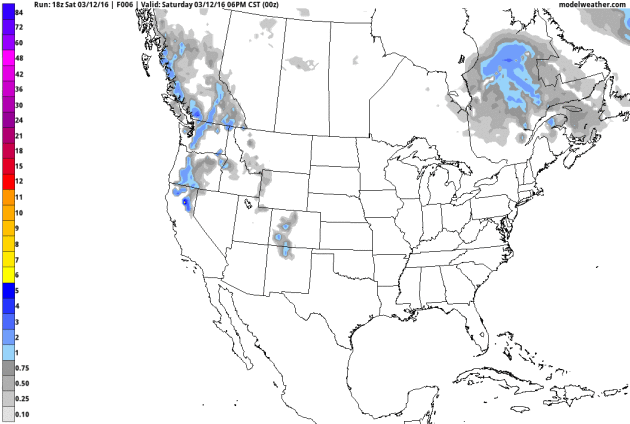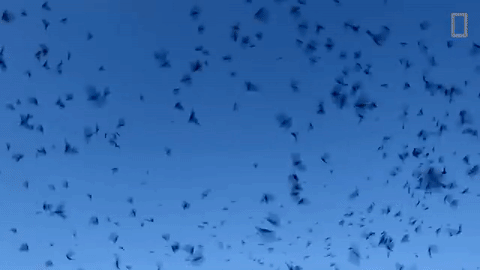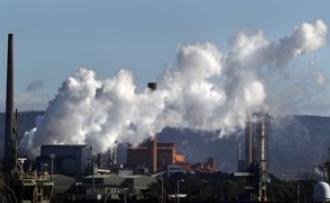70 F. record high in the Twin Cities Saturday, breaking the old record of 69F on March 12, 1990.
39 F. average high on March 12.
62 F. high on March 12, 2015.
March 13, 2006: A March snowstorm dumps 9.9 inches at the Twin Cities.
March 13, 1851: Before the spring green-up, dry grassy areas are a fire risk. On this date prairie fires blazed in Minnesota.
 Premature April Showers - Then Cooling Off
Premature April Showers - Then Cooling OffThere's a first time for everything.
On Saturday,
at our cabin north of Brainerd, I was wandering the beach in shorts and
a T-shirt, fiddling with the A/C in my truck, wondering out loud what
month it was. March or May?
Gloriously unsettling.
Weather
never repeats but sometimes it rhymes. 2016 is looking more and more
like 2012, when flowers were blooming in late March and Minnesotans
enjoyed a 7-month boating season. The reptilian side of my brain is
enjoying this immensely - my analytic side has nagging doubts.
The premature ripple of warmth that triggered a new record high in the Twin Cities
Saturday pulls enough moisture north for spotty rain showers today; steadier rain
Tuesday may end as a mix late
Wednesday. The ECMWF model hints at wet snow or a sloppy mix next weekend, a raw reminder that it's still March. Slush is possible.
Temperatures
cool off into the upper 30s next weekend (average!) but GFS guidance
hints at 50s and heavy rain returning by the end of next week.
Shrinking winters, super-sized summers, May showers in March? I'm sorry, where are we living again?
Sunday Records. 70 F. in the Twin Cities broke the old record set in 1990. It's the normal high for May 18.
A Long, Slow Slide.
Not exactly arctic, but a "temperature readjustment" is brewing later
this week as the mercury droops into the 40s - GFS guidance predicts
highs in the upper 30s next weekend. Graphic: Aeris Enterprise.
March Stages a Sloppy Comeback.
The transition back to "average" will whip up a few waves of
precipitation: showers today and Monday; steadier, heavier rain Tuesday.
Another southern storm may push a shield of moisture into Minnesota and
Wisconsin next Saturday; the atmosphere marginally cold enough for wet
snow or a mix. Way too early for details - not sure it's even real yet.
Heavy Rain Potential Tuesday.
Our internal model ensemble sent out an alert yesterday for a potential
of 1" or more of rain by 4 PM Tuesday in the Twin Cities.
In Honor of St. Patty's Day: Plenty of Green.
A spurt of southern moisture pushes showers into Minnesota this
morning; spotty showers spilling into Monday with a few hours steadier,
heavier rain Tuesday as colder air arrives on gusty northwest winds. 12
KM NAM future radar: NOAA and AerisWeather.
Greening Lawns Within 2 Weeks?
I can't promise flowers will be blooming in March (like 2012) but NAM
guidance prints out some half inch rainfall amounts around the metro
area, a few isolated 1" rainfall totals by Tuesday morning over central
Minnesota.
Premature April Showers.
NDFD, GFS and GFS ensemble model data all print out over 1" of
precipitation by Friday morning (the vast majority falling as rain).
Minor Weekend Slushing?
10-Day GFS accumulated snowfall predictions pull in a slushy coating by
Friday and Saturday; heavier amounts over far northern Minnesota by
Sunday and Monday. One more chance to fire up the snowmobiles? Don't
hold your breath.
Is March Still The 3rd Snowiest Month of the Year? Mark Seeley answers a question at
Minnesota WeatherTalk that caught my eye; here's an excerpt: "...
Using
a 115 year climate record from Detroit Lakes (Becker County), just up
the road from Perham is revealing with respect to seasonal snowfall
distribution. In the first 75 years of climate records at Detroit Lakes
March was the snowiest month of the snow season over a third of all
years. But since the winter of 1965-1966 it has been the snowiest month
of the season only three years (1985, 1996, and 2002). Further much more
of March precipitation has fallen as rain rather than snow in recent
decades. Since the new millennium, March has on average been the 3rd
snowiest month of the snow season trailing December and January, at
least in the Detroit Lakes area..."
The Fuel Behind Louisiana's Torrential Rains, Floods. Here's a clip from
Climate Central: "...
In
general, climate scientists expect heavy downpours to increase over the
U.S. and elsewhere, as a warmer atmosphere can hold more moisture,
making more of it available to fall as rain. Observations have already
shown an increase, though the amount varies from region to region. The
Southeast as a whole has seen a 27 percent increase in the amount of
rain falling in the heaviest events since 1958. Baton Rouge ranks among
the top 20 cities in terms of the increase in heavy downpours it has
seen, with a 120 percent increase since the 1950s, according to a Climate Central analysis..."
Animation credit above: "
Animation rains measured by NASA's Global Precipitation Measurement satellite." Credit: NASA/JAXA/SSAI, Hal Pierce.
1-in-200 Year Flood for Louisiana? So says Dr. Jeff Masters at
Weather Underground,
analyzing the unusual (stalled) storm that sparked thunder-snow for
Mexico and a 7-day firehose of Gulf moisture for the Lower Mississippi
Valley: "
A remarkably rare atmospheric event is unfolding over
Mexico and the Southern U.S., where an upper-level low pressure system
of unprecedented strength in the historical record for that location has
stalled out, bringing multiple days of torrential rain to the Southern
U.S. and snow to the mountains of Mexico. The upper low tapped into an
atmospheric river of moisture from both the Western Caribbean and the
Eastern Pacific, bringing rainfall amounts one would expect to occur
only once every 200 years (a 0.5% chance of occurrence in a given year)
over portions of northern Louisiana..."
Map credit above: "
500-mb map for 00Z (7:00 pm EST) Thursday, March 10, 2016, as initialized in the GFS model." Image credit:
NOAA/NCEP.
 Parade of Storms from Space
Parade of Storms from Space.
High-resolution visible satellite imagery from Friday shows the nearly
stationary storm over Mexico responsible for historic flooding across
Louisiana - a conga-line of storms lined up for the west coast. Source:
CIMSS, University of Wisconsin.


Here's What Climate Change Has Done To The Season Formerly Known as Winter.
This winter El Nino amplified the warmth, but keep in mind that flowers
blooming in Minnesota in March, 2012 had nothing to do with El Nino.
These glimpses of unusual warmth will become more frequent, especially
during the winter months. Here's an excerpt from
Vice News: "...
While
scientists hesitate to pin any one event on climate change, the pattern
over the past few decades has been for winters to get warmer and
warmer, said Katharine Hayhoe, director of the Climate Science Center at
Texas Tech University. "We're still going to have cold weather, cold
temperatures, snow and ice," Hayhoe said. "But what we're used to is
changing. So nowadays, when we get a winter that was the typical winter
when we were little, we say 'Oh my goodness, what an unusual winter.'
Well, that used to be the normal winter. "Winters like this winter that
are so far above average are reminders that things really are changing
and we are seeing things that are different than they used to be
before," she said..."
Image credit: Photo by Laurent Gillieron/EPA.
In The Arctic It Was More Than 10 Degrees (C) Too Warm. I used
Google Translate to share a story excerpt from Suddeutsche Zeitung in German: "...
Experts
from the European Centre for Medium-Range Weather Forecasts (ECMWF)
could in an area extending from Finland to Greece and to the east
through Western Siberia, Kazakhstan and the northern part of Western
Asia, measure significant changes in temperature.
In February, the temperature in this area by more than five degrees
above the monthly average - compared with the month of February from 1981 to the of 2010.
Even more than ten degrees above the monthly average temperatures were
in the northern part of the Barents Sea and the North-West of Russia, so
in parts of the Arctic..."
February temperature anomalies above: ECMWF. Graphic credit: NASA GISS.
U.S. East Coast Sea Level and The Gulf Stream.
Sea levels are rising, but fluctuations in the intensity of the Gulf
Stream can magnify the effects; here's an excerpt of a post from Dr.
Larry Atkinson at WunderBlog: "...So
how will the Gulf Stream change if climate is changing? Well, for a
long time oceanographers predicted that under a warmer future climate
the Atlantic Ocean circulation (represented by AMOC) will slow down. In
high latitudes water will become warmer and fresher (from melting ice),
so they will be less dense and will not sink as fast as before.
Therefore, if the Gulf Stream will also weaken, sea level along the
coast will rise. Recent research in fact found evidence in data that
this Gulf Stream slowdown may have started already and the result can be
seen in accelerated rate of sea level rise (Link)
The figure below demonstrates that during periods of slowdown in the
Gulf Stream, coastal sea level is often higher than normal, causing
increase in flooding..."
 The Global Solution to Extinction. Here's an excerpt from The New York Times: "...But
today the dream is at risk. Civilization is at last turning green,
albeit only pale green. Our attention remains focused on the physical
environment — on pollution, the shortage of fresh water, the shrinkage
of arable land and, of course, the great, wrathful demon that threatens
all our lives, human-forced climate change. But Earth’s
living environment, including all its species and all the ecosystems
they compose, has continued to receive relatively little attention. This
is a huge strategic mistake. If we save the living environment of
Earth, we will also save the physical, nonliving environment, because
each depends on the other. But if we work to save only the physical
environment, as we seem bent on doing, we will lose them both
The Global Solution to Extinction. Here's an excerpt from The New York Times: "...But
today the dream is at risk. Civilization is at last turning green,
albeit only pale green. Our attention remains focused on the physical
environment — on pollution, the shortage of fresh water, the shrinkage
of arable land and, of course, the great, wrathful demon that threatens
all our lives, human-forced climate change. But Earth’s
living environment, including all its species and all the ecosystems
they compose, has continued to receive relatively little attention. This
is a huge strategic mistake. If we save the living environment of
Earth, we will also save the physical, nonliving environment, because
each depends on the other. But if we work to save only the physical
environment, as we seem bent on doing, we will lose them both..."
Electric Cars "Cheaper" Than Petrol, Diesel Rivals in 6 Years. Climate Home has the story and projection details; here's the intro: "Within
six years, the cost of owning an electric car will be cheaper than
purchasing and running a petrol or diesel model. That’s the conclusion
of a report on the fast-expanding electric car market by
Bloomberg New Energy Finance. The report says that even if petrol or
diesel driven cars improve their fuel efficiency over the coming years,
the cost of owning an electric car – buying it and running it – will be
below that of conventional vehicles by 2022..."
Photo credit:
Fogcat5/Flickr
22 Amazing Renewable Energy Projects That Pave The Way to a Cleaner Future.
Gizmodo has the photo essay; here's an excerpt: "
There’s
a growing demand for greener, safer renewable energy sources. Sun,
wind, water, biomass, waves and tides, and the heat of the soil, all
provide alternatives to non-renewable energy. The following collection
showcases some of the most amazing renewable energy projects and
prototypes from the past few decades, including quite a few you’ve
probably never heard of before..."
Photo credit above: "
Here’s an aerial view of the solar plant of Ouarzazate, in central Morocco. The world’s biggest solar plant using photovoltaics (PV), it takes advantage of the Sahara sunshine." Photo: Abdeljahil Bounhar/AP.
 Can Republicans Learn to Love Clean Energy? Here's a clip from CSMonitor.com: "...Republican businessman Jay Faison is searching for the middle ground. His organization, ClearPath,
aims to convince conservative politicians that clean energy is a
winning cause. This week, ClearPath opened offices in Washington and
launched a $1 million digital ad campaign to promote conservative
clean-energy principles. It’s part of a broader multi-million-dollar
foundation and super PAC aimed at driving GOP support for “common-sense”
solutions to energy and climate problems. Winning over his fellow party
members may not be easy, but Mr. Faison says embracing clean energy is
critical to the future of both his party and his country.
Can Republicans Learn to Love Clean Energy? Here's a clip from CSMonitor.com: "...Republican businessman Jay Faison is searching for the middle ground. His organization, ClearPath,
aims to convince conservative politicians that clean energy is a
winning cause. This week, ClearPath opened offices in Washington and
launched a $1 million digital ad campaign to promote conservative
clean-energy principles. It’s part of a broader multi-million-dollar
foundation and super PAC aimed at driving GOP support for “common-sense”
solutions to energy and climate problems. Winning over his fellow party
members may not be easy, but Mr. Faison says embracing clean energy is
critical to the future of both his party and his country..."
Photo credit: "
This May 6, 2013 file photo shows a wind turbine farm near Glenrock, Wyo.
" Matt Young/AP/File.
Tackling Climate Change is a Profitable Opportunity, Rather Than an Expensive Problem. America has a long, storied history of turning negatives into positives. Here's a clip at Huffington Post: "...Looking
at how we consume energy and in particular the resulting waste will go a
long way in helping us better understand the real issues at stake. The
technologies we use today are 100 years old! They present a complete
lack of efficiency compared to the clean technologies available:
our combustion engines are three times less efficient than electrical
ones; light bulbs create more heat than light and in turn require
cooling devices; poor insulation of buildings and single glazed windows
continue to run up our monthly electricity bills; and, heating and
cooling systems, as well as industrial processes produce more losses
than efficiency. Why are we so demanding about modern information
technology and so relaxed about energy efficiency?..."
The Obama Doctrine. Even if you're not a fan of President Obama's policies you should read this article from Jeffrey Goldberg at The Atlantic; here's an excerpt: "...Obama,
unlike liberal interventionists, is an admirer of the foreign-policy
realism of President George H. W. Bush and, in particular, of Bush’s
national-security adviser, Brent Scowcroft (“I love that guy,” Obama
once told me). Bush and Scowcroft removed Saddam Hussein’s army from
Kuwait in 1991, and they deftly managed the disintegration of the Soviet
Union; Scowcroft also, on Bush’s behalf, toasted the leaders of China
shortly after the slaughter in Tiananmen Square. As Obama was writing
his campaign manifesto, The Audacity of Hope, in 2006, Susan Rice, then
an informal adviser, felt it necessary to remind him to include at least
one line of praise for the foreign policy of President Bill Clinton, to
partially balance the praise he showered on Bush and Scowcroft..."
The "AT&T Spokesperson" is a Political Refugee.
Unless you have Apache, Cheyenne or Sioux blood chances are you're the
offspring of an immigrant. So is the gal who shows up in those
ubiquitous AT&T ads on TV, a political refugee who came to the USA
from Uzbekistan when she was 2 years old. Here's an excerpt at
looper.com: "...
Life
in the USSR wasn't exactly sunshine and rainbows for Vayntrub's family,
especially because they faced persistent religious persecution for
being Jewish in a country that was officially atheist. When Vayntrub was
just two years old, her family fled Uzbekistan in hopes of finding
religious freedom and political asylum in America. The process was long
and grueling, with the family stranded in both Austria and Italy for a
while. Luckily, the Vayntrubs made it to America and settled in
California, which sounds like a wonderful step up to us..."
 Computers Will Overtake Us When They Learn to Love, Says Futurist Ray Kurzweil
Computers Will Overtake Us When They Learn to Love, Says Futurist Ray Kurzweil. I'll be happy if I can get my computer to work - without pleading, swearing and shrugging.
CNN Money has an interesting story; here's a clip: "
Ray
Kurzweil, the celebrated American inventor who keeps predicting the
future with scary accuracy, says computers will match -- and possibly
beat -- human intelligence by 2029. Here's the trick: By then, computers
will possess emotions and personality. "When I talk about computers
reaching human levels of intelligence, I'm not talking about logical
intelligence," Kurzweil said at an event in New York on Monday night.
"It is being funny, and expressing a loving sentiment... That is the
cutting edge of human intelligence..." (File image: CNN).
The Real-World Locations of 14 Sci-Fi Dystopias.
From Blade Runner to the Hunger Games to The Matrix, where did they
film these scenes (it wasn't all CG, or computer graphics). Atlas Obscura has a long, visual and fascinating story; here's an excerpt: "...The
Metacortex building, where Neo (Keanu Reeves) works as a programmer and
first suspects something’s not right with the world, is actually the
Metcentre, a shopping mall in Sydney’s Central Business District. The
bridge where Neo waits for Trinity (Carrie Ann Moss) to collect him in a
car and bring him to meet Morpheus (Laurence Fishburne) is the Adam
Street Bridge near Sydney’s Chinatown..."
Photo credit:
Metacrotex (photograph by Kenneth Pinto)
Batnado! Just when you thought you saw everything, along comes this post at
Tech Insider: "
When dusk falls, 20 million Mexican free-tailed bats swoop out of Bracken Cave
near San Antonio, Texas. After spending the winter in Mexico, the bats
fly north to procreate. By August, the pups can fly and the colony size
reaches its peak. Each night, the Bracken bat colony can eat 200 tons of moths, according to the Texas Parks and Wildlife Department. Feel what it's like to stand at the cave's entrance in this awesome video from National Geographic..."

 TODAY
TODAY: Showers taper, cooler - still well above average. Winds: SE 10-15. High: 56
SUNDAY NIGHT: Cloudy with drizzle. Low: 48
MONDAY: Damp, a few showers possible. Winds: SE 5-10. High: 58
TUESDAY: Windy. Steadier, heavier rain expected. Winds: NW 15-30. High: 59 (falling rapidly)
WEDNESDAY: Light mix tapers - wet roads. Winds: NW 15-25. Wake-up: 40. High: 44
THURSDAY: Jackets return, few flurries. Winds: NW 10-20. Wake-up: 32. High: near 40
FRIDAY: Gray, few sprinkles or flurries. Winds: 7-12. Wake-up: 31. High: 42
SATURDAY: Chance of snow or sloppy mix. Winds: NE 10-15. Wake-up: 33. High: 38
Climate Stories....

Miami Beach Mayor Rips Rubio: He "100 Percent" Sounds Like a Climate Change Denier. Here's an excerpt at
Raw Story: "...
Philip
Levine, mayor of neighboring Miami Beach, said Rubio was “100 percent
using the language of a climate change denier” and has overlooked the
escalating problem of sea level increases for south Florida. Miami Beach
has already spent $100 million on new sea defenses to curb the regular
flooding of its western half. Sea levels are expected to rise
in south-east Florida by six to 10 inches by 2030, with ever increasing
levels throughout the century unless greenhouse gases are severely cut.
These increases risk inundating large areas of the region, with 2.4
million people living within 4ft of the local high tide line..."
Money Doesn't Matter: White People Breathe Cleaner Air. Here's an excerpt of a story at
Grist that made me do a double-take: "...
For
the most part, even when controlling for poverty, race is a far better
indicator when it comes to determining who lives under a cloud of
pollution in the United States. Thanks to a new, interactive air pollution index
created by the National Equity Atlas, you can have a closer look at
what that means, state to state and city to city. Here’s how it works:
The average person in the U.S. lives in a place that ranks in the 50th
percentile for air pollution exposure, based on the EPA’s 2011 National Air Toxics Assessment.
Anyone below the 50th percentile is essentially breathing better air
than the average American, and anyone above the 50th is worse off..." (Graphic:
National Equity Atlas).
Racism and the Effects of Climate Change.
Those with the least are first to be impacted by a more volatile
climate, making this the civil rights movement of the 21st century.
Here's an excerpt at
The Philadelphia Tribune: "...
Fifty
percent of people of color live within two miles of areas of
pollution,” said Beverly Wright, executive director of Dillard
University’s Deep South Center for Environmental Justice. “There need to
be buffers. We need a special distribution of polluting facilities. The
people least responsible are the most affected.” Wright said those
involved in environmental justice have a tough job fighting against
corporations, utilities and government officials who are intent on
decimating the environment. The professor said race is a predominant
indicator that determines the exposure some communities receive to
assorted toxins, chemicals and pollutants. “Climate change is a threat
multiplier for the Black community,” said Leslie Fields, director of the
Sierra Club’s Environmental and Community Partnership Programs. “Our
children have asthma, miss school, fall behind and end up in the
school-to-prison pipeline. African Americans are disproportionately
affected by climate change and are demanding action..."
File photo: Tim Wimborne, Reuters.
How Climate Change Challenged, Then Strengthened My Faith. Here's an excerpt of an Op-Ed at
Religion News Service: "...
When
I was younger, God’s presence in nature was affirmation of this. When
it dawned on me that creation itself was actually being destroyed, my
faith faltered. Now, I realize that God is revealed to us not only
through creation, but even more so through the suffering we feel on
account of our love for it. I feel the Holy Spirit within me when I
advocate for climate justice, and 10 times more strongly when I see the
millions of others doing the same. I see Christ in the faces of those
putting themselves on the line to preserve this planet for our children,
and I know that God has not abandoned us, but is very much with us."

T
ruth in Advertising. Here's an excerpt of an interesting article from
EnergyDesk at Greenpeace: "...
Across the Atlantic and in complete contrast, North Vancouver is implementing compulsory anti-smoking-style warning stickers for fuel pumps at petrol (or ‘gas’) stations. These
ads will use text and images to remind customers of the climate impact
of the fuel they’re buying, in the hopes that drivers will consider
their fuel consumption more carefully and perhaps drive more
fuel-efficiently. Or just drive less. Do it for the moose, Canada."
Climate Change Impact on Agriculture May Be Underestimated. Here's an excerpt at IFT.org: "...This
study, which focused on an area in Brazil called Mato Grosso, found
that if the patterns from 2002 to 2008 hold in the future, an increase
in average temperature of just 1 degree Celsius will lead to a 9%–13%
reduction in overall production of soy and corn. In addition, though,
how farmers react to these changes will also impact production. For
example, farmers might choose to put less land area into production
because it is not profitable, or they might choose not to plant a second
crop in a growing season—a common practice in Mato Grosso known as
double cropping..." (File photo: Nati Harnik, AP).
What Weather Is The Fault of Climate Change? Are we really spiking storms and droughts? The problem of attribution is addressed by climate scientist Heidi Cullen at
The New York Times; here's an excerpt: "...
But some of our weather has changed significantly, and now a new report
from the National Academies of Sciences, Engineering and Medicine has
outlined a rigorous, defensible, science-based system of extreme weather
attribution to determine which events are tied to climate change. Like
the surgeon general’s 1964 report connecting smoking to lung cancer, the
report from the National Academies connects global warming to the
increased risk and severity of certain classes of extreme weather,
including some heat waves, floods and drought. This is an important
development. Climate change can no longer be viewed as a distant threat
that may disrupt the lives of our grandchildren, but one that may be
singled out as a factor, possibly a critical factor, in the storm that
flooded your house last week. The science of extreme weather attribution
brings climate change to our doorsteps..."
* More perspective on the new NAS study from Chris Mooney at
The Washington Post.
Links Between Climate Change and Extreme Weather Are Increasingly Clear and Present. Here's more perspective on the NAS report from Capital Weather Gang: "...
We
obtain those answers by comparing the event that just happened to a
reconstruction of what might have happened if humans hadn’t changed the
climate. In one common method, scientists perform many realistic
computer model simulations, over long times (in computer years), of both
the present climate, and the climate of a hypothetical, cooler world
without human influence. In each climate, they count how often events
occur that are similar to the one that happened in the real world. If
they happen twice as often (say) in the simulated present climate as in
the hypothetical climate without humans, then we say that human-induced
climate change made the event twice as likely as it would have been
otherwise. Of course, the results could also show that the event is
about equally likely in both climates, or less likely in the present
climate (as is generally true for extreme cold snaps)..."
Image credit: National Academy of Sciences, 2016.
Record Annual Increase of CO2 Observed at Mauna Loa in 2015. Here's an update from
NOAA: "...
The last time the Earth experienced such a sustained CO2 increase was between 17,000 and 11,000 years ago, when CO2 levels increased by 80 ppm. Today’s rate of increase is 200 times faster, said Tans. The big jump in CO2 is partially due to the current El Niño
weather pattern, as forests, plantlife and other terrestrial systems
responded to changes in weather, precipitation and drought. The largest
previous increase occurred in 1998, also a strong El Niño year.
Continued high emissions from fossil fuel consumption are driving the
underlying growth rate over the past several years..."
Graphic credit:
NOAA ESRL.
This Mind-Boggling Study Shows Just How Massive Sea Level Rise Really Is. Pump ocean water to Antarctica to slow the rate of sea level rise? Huh? Here's a clip from
The Washington Post: "...
The problem with using geoengineering to counter rising seas is that every millimeter of sea level rise is equivalent to 360 billion tons of ocean water. And seas are currently rising at a rate of over 3 millimeters per year,
with the rate of increase expected to grow still further in the
future. The modeling study suggests that pumping water deep into the
center of Antarctica, 700 kilometers inland and over two miles into the
air, would indeed keep it there for a good while. Here, the addition of
one meter’s worth of sea level rise would translate into raising the
total elevation of continental ice by 25 meters..."
Map credit: "
NASA's
Goddard Institute for Space Studies mapped five-year global temperature
averages. 2014 now ranks as the warmest year on record since 1880,
according to an analysis by NASA scientists." (YouTube/NASA Goddard)
Marco Rubio and John Kasich Illustrate Divide on Climate Change.
Memo to Marco: we are already - inadvertently - flavoring the weather,
and rising seas will encroach farther into your hometown in the coming
years. When you need a kayak or gondola to get around Miami Beach will
you finally acknowledge the obvious? Here's an excerpt at
The New York Times: "
Mayor
Tomás Pedro Regalado of Miami asked a question, through Jake Tapper,
about climate change, fearing that rising sea levels as a result of
climate change would cause flooding in the streets of low-lying cities,
like his own. Mr. Rubio, saying he shared the concern of South Florida’s
future, gave an answer many on the Republican side agree with: that
while the climate may be changing, there is no evidence that it is from
humans, and there is no way to enforce the other countries of the world
to comply with climate regulations. But Gov. John Kasich of Ohio didn’t
see them as mutually exclusive..."



.jpg)






No comments:
Post a Comment